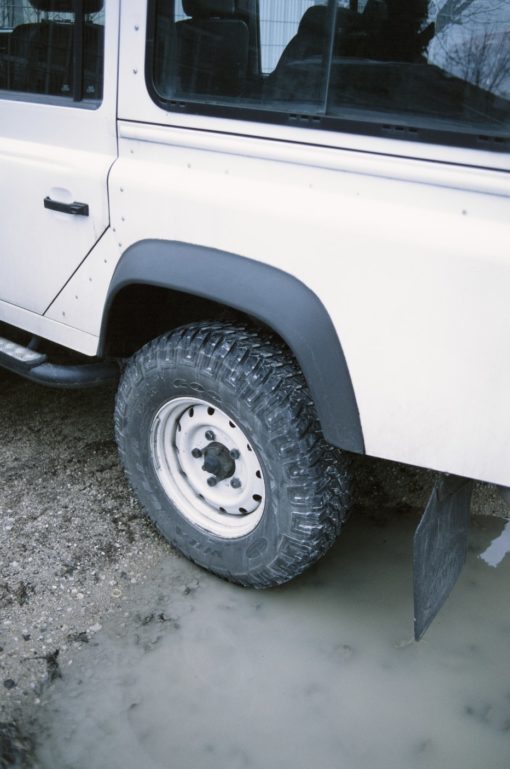
Fun Rover
April 21, 2021
Search
Popular Articles
8 Almost Useless Land Rover Mods
11th June 2014
Updated: What Makes a Defender Iconic?
29th November 2011
According to a survey from Cooper Tires, 81% of Americans have had a flat tire but only 74% say they know how to change one.

As getting a flat tire is fairly common, it’s likely that you’ll encounter one at some point—in which case, knowing how to change a flat tire is a skill that comes in handy.
Fortunately, it’s not a difficult task. You can learn how to change a flat tire in six simple steps!
1. Pull over to a safe location
As soon as you suspect that you may have a flat tire, it’s important that you don’t panic.
Instead, turn on your hazard lights so that other drivers are aware of a potential issue, and look for a spot to pull over safely. Make sure it’s well out of the way of traffic and that it’s on level ground. Never attempt to change a tire near traffic or on a hill.
When you park, be sure to engage the emergency brake so that your car doesn’t roll while you’re working on it. If available, also place blocks behind and in front of your inflated tires for extra measure.
2. Determine the extent of the damage
Next, it’s time to take a look at the problematic tire. In some cases, your tire may not need to be changed or replaced. Rather, you may be able to plug or patch it and save the tire in the process.
However, you should know the difference between a tire plug and patch, how to employ each method, and when to employ each method.
If the flat tire has a large puncture or tear, however, you’ll most likely need to go the route of changing the tire.
3. Locate all of your tools
Once you’ve determined that you have a flat tire that needs to be replaced, you’ll need to search your car for the different tools that the job requires.
At a minimum, you’ll need a car jack, lug wrench, and of course, a spare tire. While your spare tire should be located in your trunk or on the back of your vehicle, your car jack and lug wrench might be located elsewhere.
It’s not guaranteed that your car will be equipped with a spare tire. In fact, nearly one-third of new vehicles don’t come with spare tires. Investing in one will save you a major headache if you ever get a flat tire.
4. Remove the flat tire
Crack loose the lug nuts before lifting the vehicle. An 8th of a turn should be enough.
To remove your flat tire, you first need to get it off the ground. Take your carjack and locate the jacking point on the underside of your vehicle that is closest to your flat tire. Be careful to jack only on level, firm ground. Otherwise, a 2-tonne vehicle could fall over!
Use a wrench or bar to rotate the jack so that it lifts your car from the ground. When the flat tire has fully cleared the ground, use your lug wrench to remove each lug nut. Keep all lug nuts nearby, as you’ll need them to attach your spare tire.
Next, remove the flat tire from your car. In some cases, you’ll need to apply significant force to remove it. Place the flat under the chassis or sill of the vehicle, incase the jack collapses! Now, get your spare tire ready.
5. Attach the spare tire
When attaching your spare tire, make sure the valve stem faces outward. Once attached, begin screwing the lug nuts in place by hand. It’s wise to stagger the order (in a star pattern) in which you attach the lug nuts so that the tire is secured evenly.
Once you have attached each lug nut by hand, use the lug wrench to tighten them. Lower the car jack and remove it from the underside of your car. Finally, use the lug wrench once more to ensure that all lug nuts are fully tightened.
Place all of your tools, including your car jack and lug wrench, in a safe space inside your car. Recover your flat tire once it is safe to do so and place that in the boot. Congratulations—you’ve just changed a flat tire!
6. Visit your local tire store
While you’ve successfully replaced a flat tire with your spare tire, the job isn’t finished just yet.
Naturally, a spare tire is only a temporary solution. You will need to make sure you purchase a new tire (or set of tires) to replace your spare tire, as continuously driving on a spare tire can cause damage to your car.
While spare tires shouldn’t be used at speeds exceeding 50mph or for a total distance of over 50 miles, they are safe enough to get you from one location to the next.
When possible, visit your local tire store. A professional will help you find the right tire for your vehicle and replace your spare tire for you!
About Us
FunRover is a place for Land Rover enthusiasts to gather as a community and discuss the best 4x4 vehicles ever produced. We're building a library of high quality resources & articles to help owners along in their Land Rover ownership.
Popular Posts
8 Almost Useless Land Rover Mods
11th June 2014
Updated: What Makes a Defender Iconic?
29th November 2011
How to Plastidip your Land Rover Defender
19th August 2014





